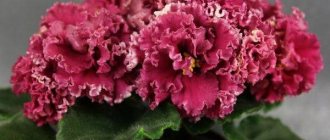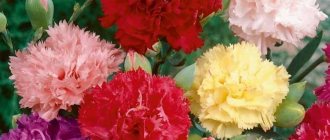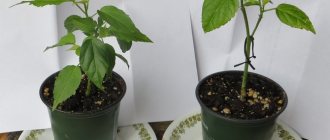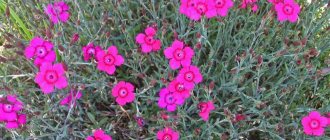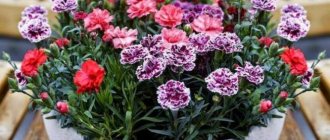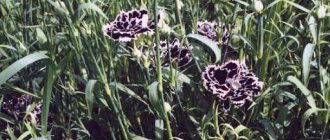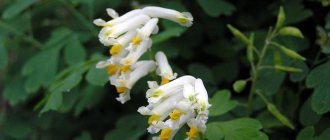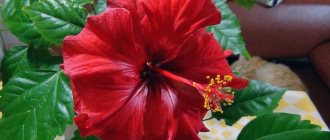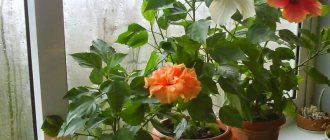Chinese carnation is the most frequent visitor to garden plots. Many gardeners take great pleasure in cultivating it, and this popularity can be explained quite simply - this flower grows quickly, and it is not fussy to care for. And at the same time, the plant has many varieties, each of which blooms in its own beautiful and original way.
Chinese carnation will give your blooming garden the brightest colors
Description of the plant
Chinese carnation is a species that unites herbaceous perennials of the Carnation genus of the Carnation family. It has been cultivated as an ornamental plant since about the beginning of the 18th century. Initially it grew in China, as well as in Mongolia and Korea, from where it was brought to European countries.
In warm regions, Chinese carnation is grown as a perennial crop, in temperate regions - as an annual plant. As it grows, it forms a small branched bush about 15-50 cm high. In general, the shape and height of the bush, as well as the duration of flowering of the plant, will depend on its varietal. Today, about 300 varieties of this type of carnation are known and their number is growing every year.
On a note! As a result of breeding work, many hybrid forms were obtained, which are characterized by a compact bush and a relatively long flowering period. However, such hybrids are quite delicate, and therefore almost all of them are grown only as annual plants!
The flowers of the Chinese carnation are double, semi-double or simple; they can be either single or collected in modest bouquets of 3-4 pieces. The buds consist of several petals and are 2-4 cm in diameter. There is practically no smell. Narrow lanceolate leaves of a dull green color sit opposite on erect stems. The height of individual shoots of dwarf varieties is no more than 15 cm; other varieties can produce stems up to half a meter long.
As you can see in the photo, Chinese carnations usually produce multi-colored inflorescences. The tones can be white, pink, burgundy, lilac, purple, scarlet, orange with clearly visible dark stripes and slits. The flowering period begins around June and lasts until August.
Popular varieties
As mentioned above, today quite a lot of hybrid varieties of Chinese carnations have been created with simple, semi-double and double flowers. And if you correctly combine several series on your site, you can create an incredibly colorful picture.
Mixed Chinese carnation is especially popular among many gardeners. Representatives of this variety are characterized by flowers of different colors. That is, in one bag there will be seeds that, when grown, will give you incredibly colorful bushes that will look most advantageous on your site. The only negative is the inability to guess what color of petals this or that plant will produce.
So, hybrid varieties of Chinese carnations, which are especially popular:
- "Diana" (DIANA F1). It produces a bush with a height of 20 to 25 cm. Flowering is early, bud formation takes the entire warm season. The flowers are large, single, of various colors. Used to decorate rockeries and alpine slides, and can be grown in containers and pots.
- "Parfait" (Parfait F1). The plant produces low bushes, about 15 cm high. However, despite this, its flowers are quite large. The varieties from this series have simple flowers, painted pink with a bright or dark spot in (Charm F1). It blooms profusely and at the same time pleases with a variety of shades. The bush is not tall, which is why it is recommended to grow it in pots or hanging containers.
On a note! These hybrid specimens were developed in a special way. They are adapted to the changing weather and growing conditions in temperate regions!
Variety selection
Nature has created about 300 types of carnations, but only about 10 are available for cultivation. The most common varieties of carnations are:
Turkish
This variety of carnation is a miniature bush on which many small inflorescences bloom.
The peculiarity of this variety is that inflorescences of completely different colors can be combined on one bush, from white to dark burgundy.
Growing Turkish carnation is absolutely no problem even for a novice gardener; it is easy to care for and grows quite quickly.
Cirrus
This variety of carnation came to us from the Alps, it looks quite unusual, and all because of its leaves with deep cuts. From a distance it may seem that these are not flowers, but terry balls.
Pinnate carnation is perfect for decorating paths or flower bed edges.
Chinese
The bluish tint is what makes this variety distinctive, the inflorescences come in different shapes, and the color usually ranges from white to dark red or burgundy.
The most common form of this variety is bicolor; many flower gardeners are confident that these are the carnations that can decorate absolutely any flower bed.
Chinese carnation
Dutch
This is a perennial variety of carnation, but this is not its only feature; it also blooms continuously, from the second half of June until the first frost.
Its color can come in a variety of shades, but the most common is red with a white border along the edge of the petals.
Dutch carnation
Features of cultivation
Chinese carnation is good because it often self-sows. In autumn, the seeds fall into the ground, where they are stratified during the winter season, and germinate with the arrival of warmth. Thus, the gardener can only plant the emerging entrances.
If you are growing Chinese cloves for the first time, then first of all you should purchase seeds. They can be found without much difficulty in specialized stores. The purchased planting material is sown immediately in open ground or grown indoors. The second option is more acceptable, as it allows you to create optimal conditions for plants and, as a result, obtain strong, healthy seedlings. However, in general, this method does not have any special advantages, since direct sowing is in any case carried out after the threat of the slightest frost has passed.
The first flowering of annuals begins three months after planting the seeds. Perennial Chinese carnation, provided proper care, begins to bloom in the second year after planting, and then only when grown indoors and stimulating flowering.
Sowing seeds in open ground
Sowing Chinese carnation seeds is done after all the snow has melted and the soil has warmed up properly. This period usually falls in the first ten days of May. The action plan is as follows:
- Dip the selected seed into a solution of succinic acid and leave for about twenty minutes. Take it out and place it on a napkin to remove excess liquid.
- We loosen the bed, remove weeds and make small furrows.
- We mix the seed material with dry sand and place it in the soil - this measure will help avoid thickening of the plantings.
- Cover the seeds with a small layer of soil, moisten the beds and cover them with plastic wrap.
Important! The seeds will sprout only if the soil temperature is approximately +15°C and the air temperature is +20°C. Moreover, these indicators must be maintained both day and night!
When growing Chinese carnation from seeds in open ground and creating all the conditions, the plant will sprout its first shoots in about three weeks. At this time, it is necessary to inspect the plantings and, if they are very dense, thin them out, removing the weakest shoots.
Sowing work - step-by-step instructions
Sowing clove seeds, although it consists of fairly simple operations, requires attention and accuracy.
- Check the disinfected containers for the presence of drain holes (if there are none, make them).
- Pour river sand (vermiculite, perlite, expanded clay) into a layer of at least 1 cm at the bottom of the seed container.
- Fill the planting container with disinfected soil mixture and lightly compact the soil with your fingers.
- Moisten the soil with settled water using a spray bottle.
- Wait 10-15 minutes until the moisture is absorbed.
- Use a stick (pencil) to make shallow (0.3-0.5 mm) indentations for sowing seeds. In a common container, the distance between grooves should be 3 cm.
- Place clove seeds into the grooves at intervals of 1.5 cm. Plant the seeds with your fingers or use tweezers.
- Sprinkle the seeds with a thin layer (2-3 mm) of soil or calcined sand. Use soil prepared for planting, but always sifted.
- Use a fine sprayer to water, avoiding erosion of the top layer of soil.
- Cover the planting containers with film, glass, or a plastic lid, creating the effect of a microgreenhouse.
Growing from seeds at home
When growing Chinese carnations at home, seeds are sown a little earlier - in April. Sow in containers filled with fertile soil, which you can make yourself by combining garden soil with sand and a small amount of perlite.
On a note! Perlite is small whitish granules that will absorb excess moisture and ensure normal air access to the roots!
- Place a drainage layer on the bottom of the container, then soil. We make small grooves into which we place the seeds. Sprinkle soil on top and moisten it.
- Cover the container with glass or polyethylene and place it under bright, diffused light, possibly on a well-lit windowsill. In this case, the room temperature should be about +20°C during the day and at least +17°C at night.
- We ventilate the plantings daily and moisten the soil in a timely manner.
- After the first thin sprouts appear on the surface of the substrate, remove the cover.
- When three true leaves appear, we put the seedlings into separate cups and water them.
Seedling care
When caring for young seedlings, it is very important to maintain moderate watering and try to maintain optimal temperature conditions. Moreover, if Chinese carnation is grown on a southern windowsill, then it is advisable to shade it at noon.
About twenty days before transplanting into open ground, it is necessary to begin hardening the seedlings. Accustoming to fresh air is carried out gradually: first, the pots are taken out into the fresh air only during the day for several hours, gradually increasing the time of the procedure. Subsequently, the seedlings are kept with the window open all the time, including at night, when the air temperature drops to +12°C.
In order for the Chinese carnation to grow into a beautiful lush bush, it must be pinched. This is done at a time when the seedlings noticeably begin to grow. Pinch off the tip above the third true leaf.
Under optimal conditions, the root system grows quite well, and therefore it may soon become too crowded. And if you notice that after watering the substrate dries out quickly, then the flower needs to be transplanted into a larger container.
Transplantation into open ground
Around the first ten days of June, we select seedlings for the flowerbed. It is important to ensure that by this time the threat of night frosts has passed and the substrate has warmed up sufficiently. Only in this case, nothing will threaten the young plants.
It is recommended to plant Chinese carnations in a sunny area, and it is desirable that the soil is fertile. It’s good if you manage to find a place that will be protected from direct sunlight on a hot afternoon - this will avoid the formation of burns on the leaves.
Important! Chinese carnation grows well in open areas, but does not tolerate direct sunlight very well. This should definitely be taken into account when choosing a place to plant a plant!
We plant the sprouts at a distance of about 25 cm from each other, sprinkle the roots with soil, and moisten the soil.
Landscape design
The Chinese carnation has become popular for its splendor and multi-colored appearance. The photo above shows how it looks along the path. Low varieties are often used to decorate such living borders, as well as for edging flower beds, to add picturesqueness to facades. They are also grown on alpine hills, but in this case we must not forget about fertilizing and soil fertility. Carnations just won’t grow among stones or in sand. This flower is ideal for decorating balconies. Carnations are also planted in flowerpots. This “place of residence” is especially convenient for perennials. To avoid turning perennial carnations into annuals in climate zones with harsh winters, it is recommended to cover them in the fall, before frosts. To do this, spruce branches are placed on the stems remaining after pruning, with a film on top. And then the entire structure is covered with earth.
Features of care
Caring for Chinese carnations is based on proper watering and timely application of fertilizers.
As for watering, it should be moderate. This plant is characterized by good drought resistance and reacts very poorly to waterlogged soil. Therefore, it is better to skip one watering than to over-water the area. After each watering, the soil around the plants must be loosened. This will provide oxygen access to the roots.
If we talk about fertilizing, then we should remember that Chinese carnation categorically does not like organic matter, so fertilizing plantings with manure is prohibited. Complex mineral fertilizers should be used as fertilizing. They are applied three times during the entire growing season. If, in regions with a warm climate, Chinese carnation is grown as a perennial plant, then when caring for it, potassium fertilizers are applied only in the second year after planting.
When to plant Chinese carnation seeds for seedlings
It is recommended to sow Chinese carnation seedlings in late February or early March. During this period, the days begin to noticeably increase, so the crop receives a sufficient amount of sunlight after planting. It is recommended to place the container on a warm southern windowsill so that by the beginning of May the seedlings are properly strengthened for transfer to the ground.
If you have a phytolamp, you can sow Chinese carnation seedlings earlier, in the middle of winter. But it is not recommended to delay planting, otherwise the crop will have to be transferred to the soil in the summer, which is undesirable.
Reproduction methods
Chinese carnations can be propagated by cuttings or dividing the bush.
Cuttings
Cuttings are carried out in June-August. The scheme is as follows:
- Select a large, healthy bush and use a hand fork to thoroughly loosen its roots.
- We lift the plant and separate the stems from each other.
- We count four pairs of leaves from the top and make a cut in this part of the shoot about 5 mm below the “heel”.
- We wrap the cut areas with a damp towel and place the stems in a plastic bag.
On a note! This procedure will help keep the cuttings moist while you harvest the rest of the shoots!
- We cut off the lower pairs of leaves from the collected stems, and coat the shoots with rooting hormone.
- We plant the cuttings in a container with vermiculite, placing them at a distance of about three centimeters from each other. In this case, it is important that the hormone remains on the plant, and the “heel” is above the soil surface.
- Cover the container filled with cuttings with glass or polyethylene and transfer it to a well-lit place. When exposed to direct sunlight, plants must be shaded.
- After three days, remove the cover.
- For three weeks, do not forget to keep the substrate moist.
If all the conditions have been met, then approximately three weeks after planting, the Chinese carnation cuttings will begin to turn slightly towards the light. This suggests that the rooting process has already begun. The roots will continue to grow for several months, and when the root diameter reaches three centimeters, the shoots can be transplanted into large pots filled with well-drained soil. Young plants will overwinter in them, being in a cool room until spring.
Dividing the bush
Chinese carnations can also be propagated by dividing the bush. To do this, in the spring or autumn, select the healthiest plants, dig them up and carefully divide them into several parts. In this case, on each of them there should be a rhizome and at least three growth buds.
On a note! Not all varieties of Chinese carnations can be propagated by dividing the bush. Only plants with fibrous root systems are suitable for this method!
Etymology of the name
This plant is called carnation in Russia. In Latin its name is Dianthus, which means "divine flower". It is believed that Jupiter and Zeus loved carnations. And her appearance in the world is associated with Artemis. The myth tells that scarlet carnations appeared from drops of the blood of a shepherd, whom the goddess of the hunt, in the heat of her anger, punished for singing. The whole history of the rise of carnations to the Olympus of popularity is in one way or another connected with struggle. The French Revolution, our October Revolution, the Second World War - this proud, beautiful flower invariably became their symbol.
Chinese carnation is a more peaceful member of the clove family. As the name suggests, it came to Europe from China, although Korea and Mongolia are also considered its homeland. At first, the distinctive feature of this species was the burgundy strokes on the petals, but over 300 years of active selection, many varieties with monochromatic petals appeared. Changes have also occurred in her life cycle. In its homeland it is a perennial. In our country, Chinese carnation is also grown as a biennial or annual.
Treatment of diseases
Chinese carnation is susceptible to both viral and fungal diseases, which can damage both the green part of the plant and its root system.
- Fusarium wilt. Its appearance will be indicated by discoloration of the leaves, a change in the color of the stem to dirty yellow and the gradual drying of the plant: the tissue of the stem turns into straw, which, when kneaded in the hand, crumbles into dust. Unfortunately, there is currently no treatment for this disease and the affected specimens die after a while. The only thing that can be done is to ensure prevention: treat healthy plants with Baktofit.
- White and brown rot. The main signs of these diseases are rotten spots on the stems of plants, inside of which the mycelia of the fungus are located. At the same time, the flowers look depressed and gradually fade. In the fight against these diseases, the drugs “Rovral” and “Fitosporin M” are used.
- Rust. It appears as yellowish pads on the stems. After some time, the infected plant dies. For treatment, Bordeaux mixture is usually used, which I spray on diseased specimens.
Important! Chinese carnations should not be planted near coniferous trees. Otherwise, rust cannot be avoided!
- Viruses. When affected by a viral disease, the foliage begins to discolor, the central veins acquire a yellowish tint, and plant growth slows down. In this case, variegation often develops. To prevent the virus from spreading to other specimens, diseased plants should be removed immediately.
Pests and diseases
Carnation has a fairly strong immune system; it is difficult for diseases and pests to defeat it. The cause of disease can be infection; to prevent this, it is necessary to disinfect the soil, container and seeds.
Another common cause of disease is frequent watering.
Rust. With this disease, red spots appear; to cure the plant, you need to remove the affected leaves and treat the plant with a solution of Bordeaux mixture.
Mosaic disease. Black and white spots, which later cause holes to form. This disease cannot be treated; the plant just needs to be thrown out and the planting site treated.
Fusarium. This disease can be identified by a change in the color of the leaves from green to yellow, and blackening of the stem is also observed. This disease also cannot be treated; the plant simply needs to be disposed of.
Many plants can die due to attack by aphids, mites or any other insects; they can eat the above-ground part of the plant
Because of them, the carnation may lose its decorative effect; laundry soap helps fight pests; you can dilute a little soap with water and spray the plants with this solution.
